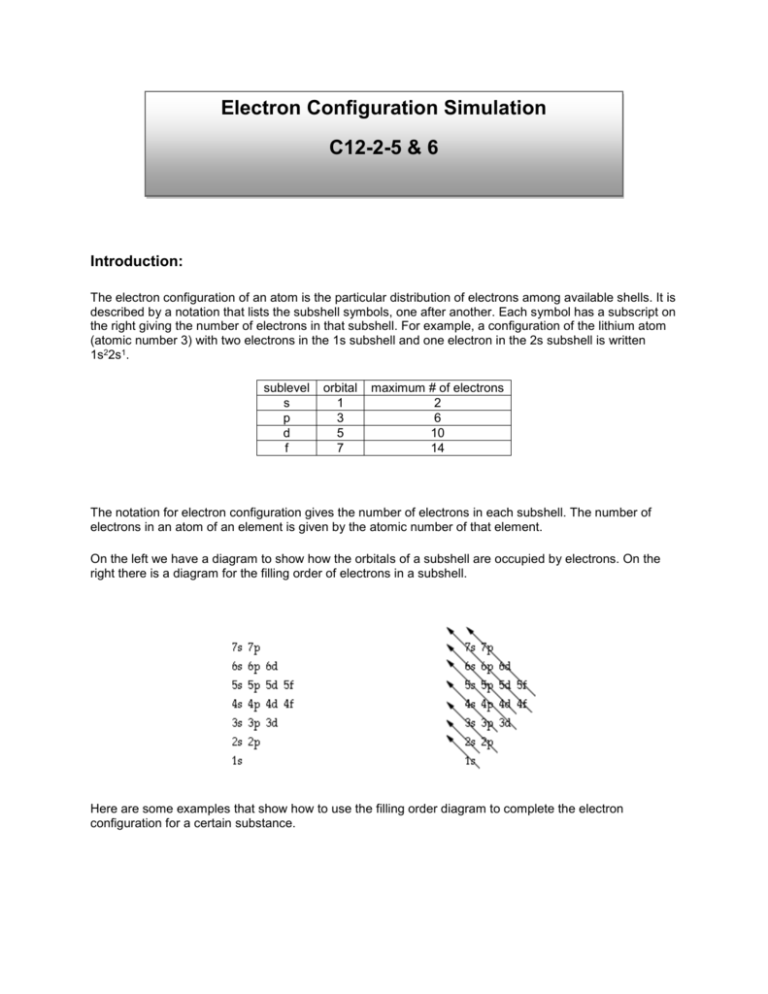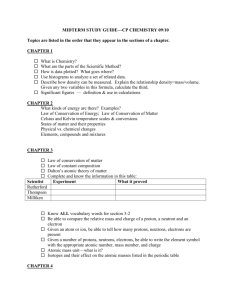Electron Configuration - Explore Learning C12-2
advertisement

Electron Configuration Simulation C12-2-5 & 6 Introduction: The electron configuration of an atom is the particular distribution of electrons among available shells. It is described by a notation that lists the subshell symbols, one after another. Each symbol has a subscript on the right giving the number of electrons in that subshell. For example, a configuration of the lithium atom (atomic number 3) with two electrons in the 1s subshell and one electron in the 2s subshell is written 1s22s1. sublevel s p d f orbital 1 3 5 7 maximum # of electrons 2 6 10 14 The notation for electron configuration gives the number of electrons in each subshell. The number of electrons in an atom of an element is given by the atomic number of that element. On the left we have a diagram to show how the orbitals of a subshell are occupied by electrons. On the right there is a diagram for the filling order of electrons in a subshell. Here are some examples that show how to use the filling order diagram to complete the electron configuration for a certain substance. Element He Li Be O Cl K # of Electrons in Element 2 3 4 8 17 19 Electron Configuration 1s2 1s22s1 1s22s2 1s22s22p4 2 1s 2s22p63s23p5 1s22s22p63s23p64s1 The three rules for filling electrons in orbitals: 1. The Aufbau Principle Each electron occupies the lowest energy orbital All orbitals related to an energy level are of equal energy. (i.e. The three 2p orbitals are the same energy level). 2. Hund’s Rule Single electrons with the same spin must occupy each equal-energy orbital before additional electrons with opposite spins can occupy the same orbitals. 3. Pauli Exclusion Principle A maximum of two electrons may occupy a single orbital, but only if the electrons have opposite spins. Exceptions to filling order are copper, chromium and some others- because half-filled shells are more stable, so an atom may borrow an electron from next s shell to half fill a lower energy level. Orbital notation for potassium: ___ 1s ___2s Noble gas notation for potassium: [Ar] 4s1 ___ ___ ___2p ___3s ___ ___ ___3p ___4s Electron Configuration and the Periodic Law: With increasing atomic number, the electron configuration of the atoms displays a periodic variation. Because of this the elements show periodic variations of both physical and chemical behavior. The periodic law is a law stating that when the elements are arranged by atomic number, their physical and chemical properties vary periodically. In this simulation, we will look specifically at atomic radius. The size of the electron cloud increases as the principal quantum number** increases. Therefore, as you look down the periodic table, the size of atoms in each group is going to increase. When you look across the periodic table, you see that all the atoms in each group have the same principal quantum number. However, for each element, the positive charge on the nucleus increases by one proton. This means that the outer electron cloud is pulled in a little tighter. One periodic property of atoms is that they tend to decrease in size from left to right across a period of the table. So, the atomic radii increases top to bottom and right to left on the periodic table. **Each electron in an atom is described by four different quantum numbers. Three of these quantum numbers (n, l, and m) represent the three dimensions to space in which an electron could be found. The n quantum number relates to the size of the atomic orbital. n can have any positive integer value from 1 to 7. The smaller the value of n, the lower the energy level, the higher the value of n, the higher the energy level. The principal quantum number, n, also equals the number of subshells. n 2 is the number of orbitals in each energy level and 2n2 is the number of electrons that can be held in each energy level. Simulation: Electron Configuration gizmo from ExploreLearning.com Purpose of this Simulation: To: 1. Create the electron configuration of any element by filling electron orbitals. 2. Determine the relationship between electron configuration and atomic radius. 3. Discover trends in atomic radii across periods and down families/groups of the Periodic Table. This simulation will allow students to have a better understanding of electron configuration and its relationship to valence electrons and the periodic table. As with all simulations, it does have its limitations and thus the activity should be combined with other practical learning activities on electron configuration. Students will be directed to a detailed “Exploration Guide” consisting of step-by-step procedures and questions to guide them through the simulation. Procedure: 1. Go to the ExploreLearning.com website. Select: Science Grade 9-12 Select” Chemistry Select: Atomic Structure and Chemical Bonding Select: Electron Configuration Select: Launch Gizmo 2. Take a few moments to examine the different parts of the gizmo: The Periodic Table, Electron Configuration, and Atomic Radius. Essentially, you can choose an element in the Periodic Table part to see its location on the periodic table and some of its properties; then, in the Electron Configuration part, you can guess and check an atom’s electron configuration; and in the Atomic Radius part, you can observe an atom’s radius on the graph. 3. Select “Exploration Guide” to view and complete the Electron Configuration and Atomic Radius activities. 4. Once you have completed the activity in the Exploration Guide, close the window and complete and check the five assessment questions located below the gizmo. 4. Finally, complete the review assignment that follows. The Periodic Table Refer to the diagrams from the gizmo below to help you with the Electron Configuration activity: Electron Configuration Below is a screen from the Electron Configuration gizmo. The element selected is potassium, an alkali metal. You have the option of having the gizmo show the number of electrons, or, you can make it more challenging for yourself and determine it from the information given on the periodic table. Potassium has 19 electrons. Knowing this, you would simply add 2 electrons per orbital, in the correct order, until you reach 19 electrons. You can then check your answer and it will tell you if you are correct or not. In the Exploration guide you will eventually determine the electron configurations for the second and third periods of the periodic table. Complete this part of the activity now. Atomic Radius In this part of the gizmo, you will use the electron configurations of the elements you have already completed (periods 2 and 3) and the graph will display the trend in atomic radius. After observing and explaining the trend in atomic radius, you will then determine the electron configurations for Group 1 (the alkali metals). Once you have completed this, you will observe the trend in atomic radius for Group 1. An example displaying the trend in atomic radius for group 1 is below: Again, the Exploration Guide will take you through the activity. Complete this part of the activity now. Once these first two parts of the activity are completed, there is an optional extension activity using the diagonal rule for electron filling. Complete this section if time permits. Once you have gone through the Exploration Guide and have answered all questions within, complete the Review activity below. Review Questions: 1. Given the following part of an electron configuration, 4s1, explain which part refers to the number of electrons, the energy level and the sublevel. 2. What is the maximum number of electrons that can occupy a single orbital? Which principle states this? 3. Which principle states that each electron occupies the lowest energy orbital? The filling of electrons into orbitals is quite easy for the first few elements but gets complicated as the number of electrons in the atom increases. Explain the “diagonal rule” and state the order of filling orbitals, starting with the 1s orbital. 4. State and explain Hund’s Rule. Write the electron configuration (orbital notation) for carbon using this rule. 5. Write the electron configuration (orbital notation with arrows) for each of the following elements: a) Silicon b) Copper 6. 7. For each of the following electron configurations, name the element: a) ___ 1s ___2s ___ ___ ___2p b) ___ 1s ___2s ___ ___ ___2p ___3s ___ ___ ___3p ___4s ___ ___ ___ ___ ___3d Each of the following electron configurations has something wrong with it. For each one State what the mistake is Re-write the electron configuration correctly, keeping the total number of electrons the same. a) ___ 1s b) ___ 1s ___ ___ ___2p ___2s ___ ___ ___2p ___3s ___ ___ ___3p 8. Write the electron configurations using noble gas notation for the elements in Group 1 of the periodic table. Which orbital is the last to be filled in all cases? Do the same for Group 2 of the periodic table. State the relationship between the electron configuration of an element and its position on the periodic table. 9. State the relationship between group number and the number of valence electrons for each element. 10. Write the electron configurations for period 2 elements. What is the relationship between the period number and the energy level of the valence electrons? 11. On the blank Periodic Table below, draw circles to represent the trend in atomic size for: a) A group b) A period 12. Explain the trend from top to bottom. 13. Explain the trend from right to left.







